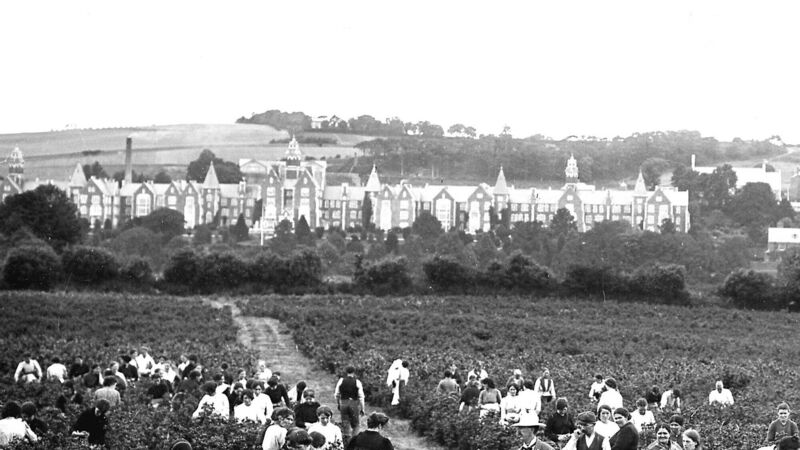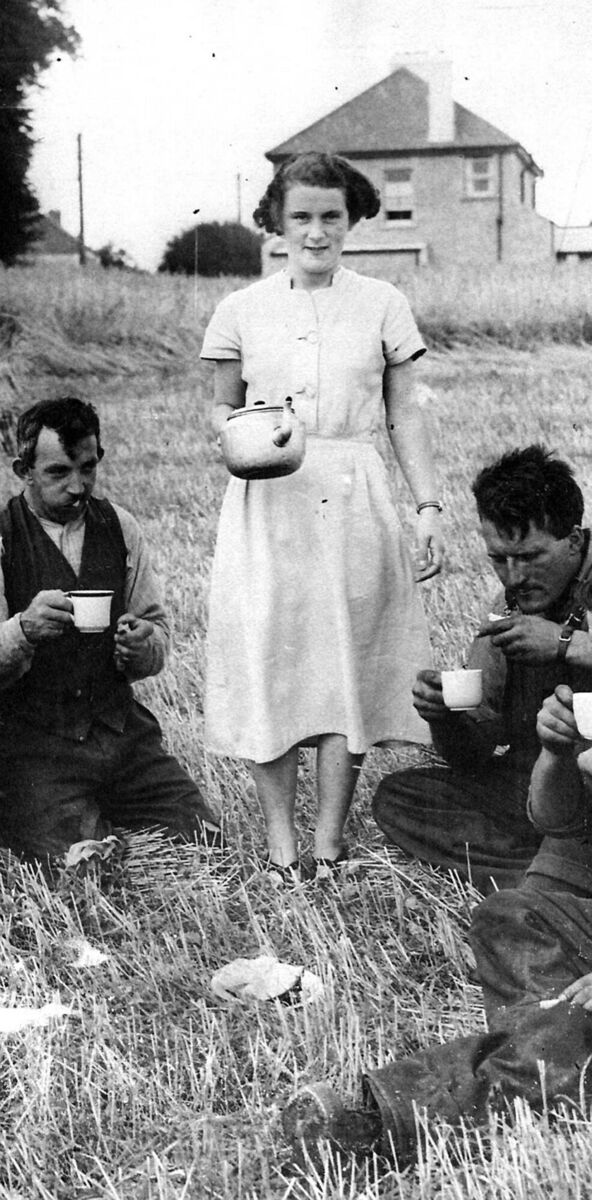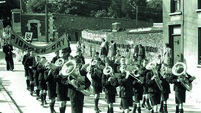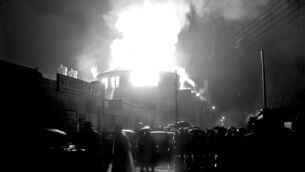Days when we went fruit-picking for pocket money

People raspberry-picking at Jennings Farm in Cork in July, 1905
WE were talking last week of the fruit farm at Rathcooney and mothers going out on summer evenings to buy the produce for jams and jellies.
But how did the fruit get into the big tent in the first place? And how, for that matter, did it get on to the shelves in the shops of Cork?
Several readers have written on that topic, most notably Richard Goodison in his delightful book of memories, Daisychains And Trout.
Thinning turnips for farmers was one option, he relates, but a more attractive form of holiday work was at Rathcooney.
“When I went there, it was run by Lt Col Grove-White, a tall softly-spoken, moustachioed gentleman whose house was up at the end of a very long avenue, and whose fruit fields lay on top of the sloping hills of Rathcooney itself,” recalls Richard.
“A youngster might have to apply to the Colonel two or three years in advance, as the jobs available were coveted by many, especially from such areas as Glanmire, Mayfield, Montenotte, Gardiner’s Hill, Dillon’s Cross.”
The first crop to be saved, explains Richard, was that of strawberries, which were sold to shops in the city and to Ogilvie & Moore in Parnell Place for the making of jam.
“Picking took place in two sessions each day during the fruiting season, once very early in the morning and again at about 4pm when the sun was on the descent.
“Of course, one was crouching down or kneeling while picking the fruit. This was uncomfortable and the cobwebs of sleep might still remain when we had risen at an uncustomary hour and had cycled out the two or three miles on our sometimes shaky old bicycles.
“Each picking session went on for two hours. The fruit was put into punnets and we were paid by the hour,” adds Richard.

“The work was supervised by Colonel Grove-White himself, and by ‘Pa’ and Mrs Cotter, and ‘Con’ - people local to Rathcooney.
“A few weeks after the strawberry picking, the raspberries and loganberries would be ripe. Their plants, which were tall and delicate, were grown like trained hedges.
“The very abundant fruit was packed into baskets and we were paid by the pound of fruit. Raspberries were also sold to the shops, but large quantities, swimming in their juice, were brought by the Colonel in big tin drums to Ogilvie & Moore.”
When the strawberry fields had been cleared of most of their fruit, recalls Richard, the young gatherers would have a ‘free pick’, rather like the gleaning in cornfields of long ago.
“We were permitted to pick as much as we could of ‘Royal Sovereign’ or the like, for our own use.
“My mother used to make delicious strawberry jam with this, but there wasn’t half enough of it there! She was good at making jam.”
Also, now and again, Richard remembers, she would take a notion and make pots of marmalade. “The smell of cooking oranges would hang about the house for days. Now and again she would produce a lovely lemon curd, but most exciting of all was her ‘toffee’.”
Ah, who remembers making toffee at home over the kitchen stove? Pots burned, product hopelessly sticky or rock hard, but what a thrill! Quite different to buying a penny bar like a Giftie, that had to be cracked on the corner of a handy brick wall. This was home-made, the real stuff!
The Colonel had other fruits growing on his land, says Mr Goodison, “but we were called only for the summer strawberry and raspberry picking. We worked hard enough, we didn’t get rich, but we had something to do and somewhere to go, and we were not penniless!”
Eileen Barry also remembers strawberry picking season at Rathcooney during one long-ago summer.
“We were at that pre-teen age when we would do anything to earn money for sweets or ice-lollies, and we saw an ad from the fruit farm asking for workers,” says Eileen.
“I signed up with my sister and a friend of ours. You had to be there very early in the morning - was it six o’clock? Something like that.
“We had a caravan in our yard at the time, and the three of us slept in there so that we wouldn’t wake the whole house up when we got up at five.
“Then we cycled a few miles up to Rathcooney and worked for a couple of exhausting hours, down on our knees, picking and filling those little flat boxes which by eight o’clock had to be on their way down to the city.”
Eileen adds: “You weren’t supposed to eat any, but of course we did! Funnily enough, you got tired of them after a while.
“Pay? We got the princely sum of 1/3d an hour. I know we found it drainingly tiring, and could hardly get up the energy to cycle home for breakfast!”
Mike English has vivid memories of earning money during the summer school holidays of the 1950s. “All I could find to do were farming jobs that applied in the late ’50s,” he said.
Out in Bishopstown, as it was then, houses were far fewer and farmland spread far and wide on all sides. As a result, young lads were welcomed for the hard work they could put in.
“Mostly it was thinning turnips and carrots (with heavy jute bags tied around our knees), planting cabbage, spuds and corn, and harvesting them later,” says Mike. “Potatoes were sprayed with Bluestone (I think) to prevent blight. This was applied from a horse-drawn contraption in the shape of a barrel, with the driver sitting on top. A lot of the work was done with horses back then, until the herald of a new age, when a Massey Ferguson tractor arrived. Then I was allowed to do the harrowing and rolling, but never got to do the ploughing.”
Presumably, that required a very skilled operator, to get those furrows straight and clean.
Incidentally, how many can boast of being able to plough a straight furrow with a pair of heavy Clydesdales these days?
Well, Zwena McCullough for one, one of Ireland’s very few ploughwomen.

Born a Quigley of the legendary St Anne’s Hydro in Blarney, she has always espoused the cause of horse-power and regularly competes at the National Ploughing Championships. But how many other Corkonians would still know how to put on the harness?
Back to Mike English’s backbreaking summer work...
“I would also do the milking twice a day when required, and the cows had their own names back then, not like the tags of today. It was real milking too.
“Locals called in during the evenings with their jugs for a pint or two and always got a drop extra, known as a ‘tuilleagh’ ie, extra.”
Ah, so that’s where the phrase ‘a tilly for the cat’ came from! Thank you, Mike, now we know!
A man from the Department came at intervals to take samples and check the yields of each cow, explains Mike. Change was on the way, though.
“Big developments came with the purchase of a modern sit-on potato and cabbage planter. With this you could plant three rows at a time, which was a revelation in the ’50s.
“Now a field could be planted in a day, which would have taken days with manual planters, one on the spade and the other slotting in the plant.
“Picking potatoes was a back-breaking job for the first few days. The regular potatoes went to the market while the small ones were cooked (in a sawdust burner) for the pigs. Which reminds me of the worst job on offer - cleaning out the pig houses. These were low-built, to retain heat for the pigs, but this made it very difficult to clean them. The smell lingered for days!
“This manure, as well as that from the cow stalls, went back into the land of course - the natural round of nature.” The best days Mike remembers were the ones saving the hay or cutting corn. “Cutting, turning and raking it into small hay cocks at first, before drawing it into the hay shed,” he recalls.
“I can still remember the old reaper and binder machine cutting the wheat, barley or oats, and putting the sheaves in stooks before threshing.
“My job at the threshing was to remove the chaff as it came off the machine, before I was promoted to manning the feed of corn into the bags, which were then transported on hand trucks to the loft. The combine harvester took over after that.
“The days always seemed sunny back then, and the tea and home-made bread tasted so much better sitting on a cock of hay.
“On really wet days in the fields, we might shelter in a ditch waiting for the shower to pass and a forbidden Woodbine cigarette would be lit up.
“Another job for wet days was whitewashing the cow stalls and stables. In a pre-wrist watch era, we depended on the Angelus bell from the African Missions church at 6pm to tell us our day’s work was done, except on days when we might work on until 9 or 10pm if some job needed completion.
“Another nice job was turning the grain in the loft to prevent it from heating,” adds Mike. “This was fed into a mill which ground it for animal feed. All very self-sufficient.
“The money was good at ten shillings a day (about 50 cent today). We worked mostly 9am to to 6pm with an hour for dinner. Dinner was in the middle of the day back then, if you remember.”
Indeed it was, Mike. So many of us grew up with that scurry home in the middle of the day for a big rib-sticking dinner, and then the rush back to a long afternoon of school. And even during the summer, it still remained the ‘right’ time to have the main meal of the day.
One wonders how anyone could concentrate, whether in the classroom or at work, after a hefty meal? But slowly, over the years, we graduated to having dinner in the evening. Now lunch is a movable feast, both literally and metaphorically, snatched on the run or missed out altogether.
And even dinner has become, for many modern families, a pizza delivered to the door and eaten on the sofa while watching Netflix. How times have changed!
Thank you for those great memories, Richard Goodison, Eileen Barry, Mike English, and all the others who take the trouble to write in.
If you, reading this today, find your own memory stirring with thoughts from the past, then make sure you send them to us so others can enjoy them!
Email jokerrigan1@gmail.com. Or leave a comment on our Facebook page: https://www.facebook.com/echolivecork.







